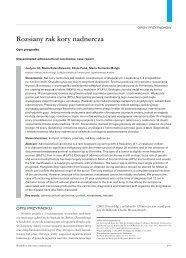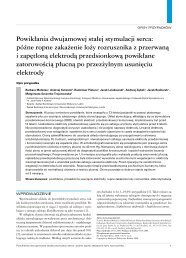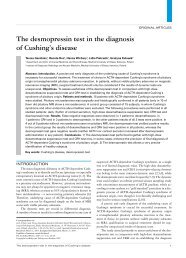Pdf version - polskie archiwum medycyny wewnętrznej
Pdf version - polskie archiwum medycyny wewnętrznej
Pdf version - polskie archiwum medycyny wewnętrznej
Create successful ePaper yourself
Turn your PDF publications into a flip-book with our unique Google optimized e-Paper software.
HISTORY OF INTERNAL MEDICINE IN POLAND<br />
Fig. 2. Babiński in his sixties. By courtesy of the Chair of History of<br />
Medicine, Collegium Medicum, Jagiellonian University<br />
Fig. 1. Babiński in his forties. By courtesy of the Chair of History of<br />
Medicine, Collegium Medicum, Jagiellonian University<br />
February 22, 1896, when the Paris Biological Society received<br />
the communication On the plantar reflex in some organic diseases<br />
of the nervous system became a historical date in neurology [5,6].<br />
Typically of Babiński, ever economical with words; the report<br />
was only 28 lines long.<br />
He supplemented the semiology of the reflex in 1903, describing<br />
toe abduction (the fan sign, signe d’éventail) [7,8]. He<br />
regarded it very important, stressing that in pyramidal tract<br />
damage, apart from great toe extension, the patient manifests<br />
also flexion and abduction of the other toes.<br />
A superb clinician, Babiński understood that knowing<br />
neurological signs in normal and pathological situations is fundamentally<br />
important in neurology. His early papers focused<br />
on reflexes and establishing which were physiologically fixed<br />
and which developed in pathological states. He demonstrated<br />
that deep reflexes are fixed, but their hyperactivity, hypoactivity,<br />
absence or asymmetry indicate a pathology, and proved<br />
that conjunctival, corneal and gag reflexes may be absent in<br />
healthy subjects, but their asymmetry indicates an organic disease<br />
background. His famous lecture On tendon and periosteal<br />
reflexes precisely defined the role of reflexivity studies [9,10].<br />
Babiński developed the semiology of organic hemiplegia<br />
and transverse spinal cord lesions, described the majority of<br />
pyramidal signs and demonstrated increased tendon and periosteal<br />
reflexes accompanied by the so-called clonus verus and<br />
toe sign as constant signs appearing in late-stage hemiplegias.<br />
He distinguished two types of transverse spinal cord paralysis:<br />
with tendon contraction or excessive tendon stretching; demonstrating<br />
defense reflexes in pyramidal tract damage and<br />
their independence of intensified tendon reflexes. Babiński’s<br />
knowledge of defense reflexes allowed for determination of the<br />
spinal cord tumor margin.<br />
Recognizing the diagnostic value of clinical characteristics<br />
of nervous system-affecting syphilis is among Babiński’s major<br />
successes. In 1899, he was the first to claim that an absent<br />
pupil reaction to light was pathognomic; together with Augustin<br />
Charpentier (1901), he showed the importance of the<br />
Argyll-Robertson pupil sign, equaling it in significance with<br />
the Hutchinson’s triad or Fournier’s pleiade [11].<br />
In 1900, one year before Alfred Fröhlich [12], Babiński described<br />
adiposogenital dystrophy in pituitary tumors. Today,<br />
this syndrome is named after Babiński and Fröhlich.<br />
Babiński concentrated on cerebellar symptomatology in<br />
1899–1913; providing the foundation for diagnostic management<br />
of cerebellar diseases. The chief paper of that period<br />
seems to be a lecture On cerebellar signs and their diagnostic importance,<br />
presented at the International Medical Congress in<br />
London and published by Babiński and his student, August<br />
POLSKIE ARCHIWUM MEDYCYNY WEWNĘTRZNEJ 2007; 117 (7)







